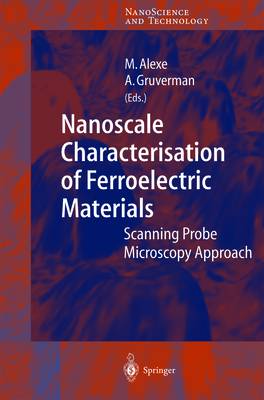
- Afhalen na 1 uur in een winkel met voorraad
- Gratis thuislevering in België vanaf € 30
- Ruim aanbod met 7 miljoen producten
- Afhalen na 1 uur in een winkel met voorraad
- Gratis thuislevering in België vanaf € 30
- Ruim aanbod met 7 miljoen producten
Zoeken
Nanoscale Characterisation of Ferroelectric Materials
Scanning Probe Microscopy Approach
€ 160,45
+ 320 punten
Omschrijving
Among the main trends in our daily society is a drive for smaller, faster, cheaper, smarter computers with ever-increasing memories. To sustain this drive the com puter industry is turning to nanotechnology as a source of new processes and func tional materials, which can be used in high-performance high-density electronic systems. Researchers and engineers have been focusing on ferroelectric materials for a long time due to their unique combination of physical properties. The ability of ferroelectrics to transform electromagnetic, thermal, and mechanical energy into electrical charge has been used in a number of electronic applications, most recently in nonvolatile computer memories. Classical monographs, such as Ferro electricity by E. Fatuzzo and W. J. Mertz, served as a comprehensive introduction into the field for several generations of scientists. However, to meet the challenges of the "nano-era", a solid knowledge of the ferroelectric properties at the nano scale needs to be acquired. While the science of ferroelectrics from micro-to lar ger scale is well established, the science of nanoscale ferroelectrics is still terra in cognita. The properties of materials at the nanoscale show strong size dependence, which makes it imperative to perform reliable characterization at this size range. One of the most promising approaches is based on the use of scanning probe microscopy (SPM) which has revolutionized materials research over the last dec ade.
Specificaties
Betrokkenen
- Uitgeverij:
Inhoud
- Aantal bladzijden:
- 282
- Taal:
- Engels
- Reeks:
Eigenschappen
- Productcode (EAN):
- 9783642058448
- Uitvoering:
- Paperback
- Afmetingen:
- 152 mm x 18 mm
- Gewicht:
- 458 g

Alleen bij Standaard Boekhandel
+ 320 punten op je klantenkaart van Standaard Boekhandel
Beoordelingen
We publiceren alleen reviews die voldoen aan de voorwaarden voor reviews. Bekijk onze voorwaarden voor reviews.







